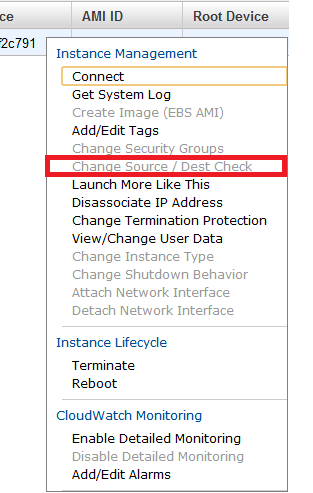This FAQ covers how to create a RightScript that will install OpenVPN client and server. There are a number of ways to use OpenVPN. This specific example covers one possible scenario but there are many others. You can modify the script to suite your needs.
Problem
- A credit card payment processing gateway identifies client connections by an IP address that is qualified through a whitelist process. Therefore we must have a set of static IP addresses (Elastic IP's).
- Application servers on scalable arrays cannot use static IP addresses on Amazon EC2 because they are in short supply. Rather, they use dynamic IP's. Unassigned EIPs are expensive (Amazon charges a premium for them) and while it might be possible to have 5-10 whitelisted EIP's it is not realistic to have dozens or hundreds.
- When a user submits a checkout they need send credit card information to a payment gateway and it needs to appear to be coming from one of the whitelisted IP's.
- All traffic must be https since this is a secure website.
Solution
Install an Open VPN client on each app server and an Open VPN server with EIP acting as a NAT gateway. A static route on each client routes traffic to payment gateway through the VPN tunnel (tun0). Other traffic is routed normally through eth0. The VPN insures that traffic from the client to the payment gateway is routed back to the client. To the payment gateway it looks like all traffic is coming from a single public whitelisted IP address.

How to Set it Up
Create the following rightscript called Install OpenVPN.
#!/bin/bash yum -y install openvpn cp $RS_ATTACH_DIR/keys.tgz /root/keys.tgz cd /root tar -zxf /root/keys.tgz if [$VPN_TYPE = "server"]; then echo "VPN Server setup" iptables --table nat --append POSTROUTING -s 172.31.0.0/12 --out-interface eth0 -j MASQUERADE echo 1 > /proc/sys/net/ipv4/ip_forward service iptables save service iptables restart cat > /etc/openvpn/server.conf << EOF dev tun proto udp port 1194 server 172.31.0.0 255.255.255.0 ifconfig-pool-persist ipp.txt key /root/server.key ca /root/ca.crt cert /root/server.crt keepalive 10 60 inactive 600 persist-tun duplicate-cn dh /root/dh1024.pem EOF fi if [$VPN_TYPE = "client"]; then echo "VPN Client setup" cat > /etc/openvpn/client.conf << EOF client dev tun proto udp port 1194 resolv-retry infinite nobind remote $VPN_SERVER_IP keepalive 10 60 inactive 600 persist-tun persist-key dh /root/dh1024.pem ca /root/ca.crt cert /root/client.crt key /root/client.key EOF fi echo "Starting openvpn" service openvpn startNotice there are two inputs that are required - click the
identify
button to identify them. The $VPN_TYPE indicates if this instance will be a client or a server. The VPN_SERVER_IP is the actual EIP of the VPN server instance.Certificates need to be generated for the client and the server.
http://openvpn.net/index.php/open-source/documentation/howto.html#pki
You can ssh into a running instance you already have and run the commands after doing a yum install openvpn. You can uninstall openvpn when you are done. You can also use a linux desktop or server with openvpn installed on it. The keys generated need to be generated for client and server and put into a tarball (keys.tgz). In order to support scaling all clients and servers use the same keys and certs. This is secure because the servers are not ever leaving the cloud (they aren't laptops wandering around the city). You can use the secure copy (scp) command from an SSH session to copy it your local machine and then use the attachments tab
of the rightscale script editor to upload it and attach it to the script.
Add the script to your existing server templates. You may want to create a new server template for the vpn server since it doesn't need much on it (all it really needs is this script - and possibly the monitoring tools and syslogging). But you can put whatever you want on it.
Open port 1194 for UDP traffic in your security group.
Start the vpn server instance. Be sure to set the VPN_TYPE as: server
When the server is running start the vpn client instance
To test the vpn from one of the client app server instance you can ssh in:
ping 172.31.0.1If you get a response the vpn is working. You can also test seting up a route. Run lynx from the instance and navigate to whatismyipaddress.com. Sscroll down and note your IP - it should be the public ip of the instance - this proves that traffic is routing to eth0 - that your instance is talking directly to the internet. To add a route through the vpn you use the commandroute add -host whatismyipaddress.com dev tun0Rerun the lynx browser and go to whatismyipaddress.com. You can scroll down and see that it thinks your IP is the IP of your NAT gateway - not the IP of your client browser.It should be the EIP of your server instances. The client is taking through the vpn tun0 adapter to the server.You will want to add the route to the payment gateway as a boot script on your app server (clients).
NOTES: The clients are automatically assigned IP addresses by the VPN server. They will keep their IP addresses. The VPN server saves each client IP in ipp.txt (ifconfig-pool-persist ipp.txt directive handles this). You can setup multiple VPN servers as well, for redundancy and can even do round robin for load balancing.
If you are having issues connecting beyond the OpenVPN gateway, and are unable to communicate with servers within the private network, you may need to log into the AWS console and un-check Change Source / Dest Check
as it looks like it may prevent routing between instances. The following screenshot shows what it looks like in a right-click context menu, within EC2 Instances:
